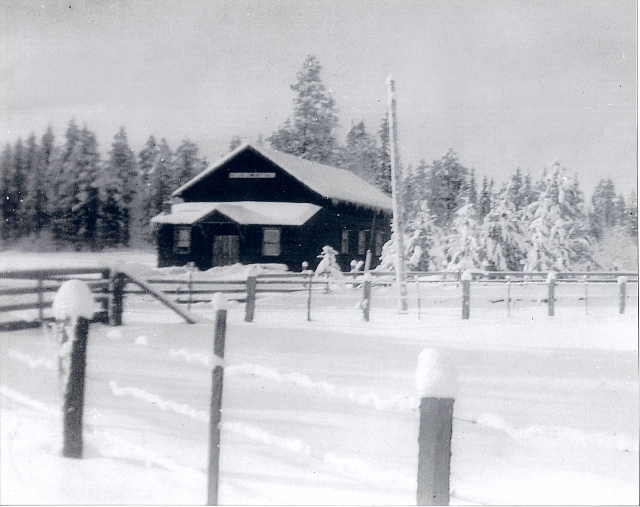The story of the old Roe Lake Hall, as told by Mrs. Lorraine Faessler,
long time resident and pioneer living at Bridge Lake with her husband Charlie

Old Roe Lake Hall
Up until the late forties the small community of Roe Lake used the North Bridge Lake School for many activities, but as the population began to grow it was soon evident that a central community hall was needed.
The building of a community hall was the brainchild of the Roe Lake Women’s Institute, which was very active at that time. To raise money for this tremendous project, fifty dollar “loans” were collected from people in the community to aid in the construction. The loans were to be paid back when the hall began making money. Gordon Ashley from Lone Butte was one of the first people to donate $50.00 instead of “loaning” it. It may not sound like much, but $50.00 back in 1952 was like a thousand dollars now. Fortunately the hall did make money and every penny was paid back.
Ed Malm donated 3 acres of choice virgin land for the proposed building and also donated much of his time and energy, working on it from the laying of the foundation until it was ready to open. Two years later the grand opening dance was held. Ed was the volunteer janitor for many years, until his health failed and he was no longer able. The job was then taken on by Forrest Bell for a few years and then by Ed’s son Howard.
The basement was excavated by Karl Larson who owned a D4 Cat he brought from the Philippines with his soldier’s settlement. The cat still had machine gun tracks on the side of the blade. Roddy Richmouth poured the cement for the building, and Amos Kellock who was a relative newcomer to the area, did the framework. The walls were then raised by volunteer labour with Clarence Kelly (one time owner of Loon Bay Resort) overseeing the job. This almost came to disaster one night during a terrific windstorm. The walls were raised and just braced for the night. During the evening a very bad windstorm started blowing and almost brought down the whole building. Fortunately men were rounded up in the evening in time to re-brace the walls before any damage resulted. The rafters, roof and siding were put on in short order and the hall was opened in 1953.
The land around the building being all brush and trees was cleared by the first Government land clearing outfit ever to come into the area.
Nearly all the work of this tremendous project was voluntary, from the cutting of the timber with a small gasoline operated sawmill owned by Marian Higgins; to the construction of the hall and the clearing of the land after the bulldozers. Many local men and women walked miles to the proposed building site carrying small children then working hard all day. Women and children piled and burned small trees, willows and brush. Older children and many of the women sawed timber and hammered on boards right along with the men. As twilight descended these families trudged the many miles home again still to do their own chores and prepare the evening meal for themselves and their children. The next day they followed the same procedure.
A close call the hall experienced during this construction period was told to me by Noveta Leavitt. She and a couple of women went over to the hall to oil the floor. It was a very hot day. During the noon lunch while sitting on the shady side of the building eating and enjoying a little relaxation, their oil soaked mops were leaning against the sunny side of the building. With the intense heat of the sun the mops started to smoke. Fortunately the women came around the building and saw the boards just beginning to scorch and smoke. They were able to extinguish the flames but their mop rags were burnt beyond use.
The first big shindig to take place in the newly completed hall was the opening dance. It was attended by people as far away as Clinton, 100 Mile House, Forest Grove and Lac La Hache, which was a considerable distance in those days of bad roads and poor means of transportation. They arrived in every type of transport from horse and wagon, horseback, walking and old Fords. One gentleman, Ole Ellington who was well known for his dancing abilities in his earlier days, surprised everyone by attending this opening. Ole was in his seventies at the time and had not been to a dance in twelve years.
Many events took place in the Roe Lake Hall over those years including weddings, funerals, church services, birthdays and golden anniversaries, Christmas concerts and badminton. One of the most significant events held in the hall was a benefit dance for Tommy Powell which netted one thousand dollars.
I remember they held a large auction at this event. My husband won a live pig in a Chinese auction while I won a shotgun which was one of the door prizes. Little did I know that during the course of the evening my husband was telling everyone (without my knowledge) that I had traded my shotgun for his pig! The pig has long since met its Waterloo but the gun is still a source of debate in our home.
A unique feature of the hall was the fir dance floor. This was cut from local trees, transported to Jensen’s Sawmill on Exeter Road (in those days a very small mill) where it was planed. The planks were brought back to Roe Lake where they were piled to dry. It stood up beautifully throughout many years of stomping and pounding of thousands of happy dancers.